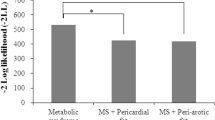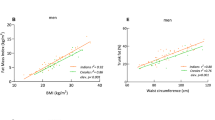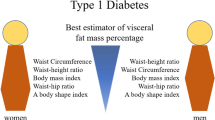Abstract
OBJECTIVE: Visceral fat, notably mesenteric fat, which is drained by the portal circulation, plays a critical role in the pathogenesis of metabolic syndrome through increased production of free fatty acids, cytokines and vasoactive peptides. We hypothesize that mesenteric fat thickness as measured by ultrasound scan could explain most of the obesity-related health risk. We explored the relationships between cardiovascular risk factors and abdominal fat as determined by sonographic measurements of thickness of mesenteric, preperitoneal and subcutaneous fat deposits, total abdominal and visceral fat measurement by magnetic resonance imaging (MRI) and anthropometric indexes.
DESIGN: A cross-sectional study.
SUBJECTS: Subjects included 18 healthy men and 19 women (age: 27–61 y, BMI: 19–33.4 kg/m2).
MEASUREMENTS: The maximum thickness of mesenteric, preperitoneal and subcutaneous fat was measured by abdominal ultrasound examination. MRI examinations of whole abdomen and pelvis were performed and the amount of total abdominal and visceral fat was quantified. The body mass index, waist circumference and waist–hip ratio were recorded. Cardiovascular risk factors were assessed by physical examination and blood taking.
RESULTS: Men had more adverse cardiovascular risk profile, higher visceral fat volume and thicker mesenteric fat deposits than women. Among all the investigated obesity indexes, the mesenteric fat thickness showed the highest correlations with total cholesterol, LDL-C, triglycerides, fasting plasma glucose, HbA1c and systolic blood pressure in men, and with triglycerides and HbA1c in women. On stepwise multiple regression analysis with different obesity indexes as independent variables, 30–65% of the variances of triglycerides, total cholesterol, LDL-C and HbA1c in men, and triglycerides in women were explained by the mesenteric fat thickness.
CONCLUSION: Compared with sonographic measurement of subcutaneous and preperitoneal fat thickness, MRI measurement of total abdominal and visceral fat and anthropometric indexes, sonographic measurement of mesenteric fat thickness showed better associations with some of the cardiovascular risk factors. It may potentially be a useful tool to evaluate regional distribution of obesity in the assessment of cardiovascular risk.
This is a preview of subscription content, access via your institution
Access options
Subscribe to this journal
Receive 12 print issues and online access
$259.00 per year
only $21.58 per issue
Buy this article
- Purchase on Springer Link
- Instant access to full article PDF
Prices may be subject to local taxes which are calculated during checkout



Similar content being viewed by others
References
Bjorntorp P . Portal adipose tissue as a generator of risk factors for cardiovascular disease and diabetes. Arteriosclerosis 1990; 10: 493–496.
Ahima RS, Jeffery SF . Adipose tissue as an endocrine organ. Trends Endocrinol Metab 2000; 11: 327–332.
Kannel WB, Cupples LA, Ramaswami R, Stokes J, Kreger BE, Higgins M . Regional obesity and risk of cardiovascular disease; the Framingham Study. J Clin Epidemiol 1991; 44: 183–190.
Bjorntorp P . The association between obesity, adipose tissue distribution and disease. Acta Med Scand Suppl 1988; 723: 121–134.
Masuda T, Imai K, Komiya S . Relationship of anthropometric indices of body fat to cardiovascular risk in Japanese women. Ann Physiol Anthropol 1993; 12: 135–144.
Woo J, Ho Sc, Chan SG, Sham A, Yuen YK, Masarei JL . Lipid profiles in the Chinese elderlies: comparison with younger age groups and relationship with some cardiovascular risk factors and presence of disease. Cardiology 1993; 83: 407–414.
Abate N, Gray A, Coleman R, Grundy SM, Peshock RM . Prediction of total subcutaneous abdominal, intraperitoneal, and retroperitoneal adipose tissue masses in men by a single axial magnetic resonance imaging slice. Am J Clin Nutr 1997; 65: 403–408.
Gray DS, Fujioka K, Colletti PM, Kim H, Devine W, Guyegkeng T . Magnetic-resonance imaging used for determining fat distribution in obesity and diabetes. Am J Clin Nutr 1991; 54: 623–627.
Ramirez ME . Measurement of subcutaneous adipose tissue using ultrasound images. Am J Phys Anthropol 1992; 89: 347–357.
Orphanidou C, McCargar L, Birmingham CL, Mathieson J, Goldner E . Accuracy of subcutaneous fat measurement: comparison of skinfold calipers, ultrasound, and computed tomography. J Am Diet Assoc 1994; 94: 855–858.
Fanelli MT, Kuczmarski RJ, Hirsch M . Estimation of body fat from ultrasound measures of subcutaneous fat and circumferences in obese women. Int J Obes Relat Metab Disord 1988; 12: 125–132.
Tadokoro N, Murano S, Nishide T, Suzuki R, Wantanabe S, Murayama H, Morisaki N, Saito Y . Preperitoneal fat thickness determined by ultrasonography is correlated with coronary stenosis and lipid disorders in non-obese male subjects. Int J Obes Relat Metab Disord 2000; 24: 502–507.
Suzuki R, Wantanabe S, Hirai Y, Akiyama K, Nishide T, Matsushima Y, Murayama H, Ohshima H, Shinomiya M, Shirai K, Saito Y, Yoshida S, Saisho H, Ohto M . Abdominal wall fat index, estimated by ultrasonography, for assessment of the ratio of visceral fat to subcutaneous fat in the abdomen. Am J Med 1993; 95: 309–314.
Derchi LE, Solbiati L, Rizzatto G, Pra LD . Normal anatomy and pathologic changes of the small bowel mesentery: US appearances. Radiology 1987; 164: 649–652.
Anderson PJ, Chan JCN, Chan YL, Tomlinson B, Young RP, Lee ZSK, Lee KK, Metreweli C, Cockram CS, Critchley JA . Visceral fat and cardiovascular risk factors in Chinese NIDDM patients. Diabetes Care 1997; 20: 1854–1858.
Ross R, Shaw KD, Rissanen J, Martel Y, Guise JD, Avruch L . Sex differences in lean and adipose tissue distribution by magnetic resonance imaging: anthropometric relationships. Am J Clin Nutr 1994; 59: 1277–1285.
Dowse GK, Zimmet PZ, Garceboo H, George K, Alberti MM, Tuomilehto J, Finch CF, Chitson P, Tulsida H . Abdominal obesity and physical inactivity as risk factors for NIDDM and impaired glucose tolerance in Indians, Greole, and Chinese Mauritians. Diabetes Care 1991; 14: 271–282.
Mathews DR, Hoskers JP, Rudenski AS, Naylor BA, Treacher DF, Turner RC . Homeostasis model assessment: insulin resistance and β-cell function from fasting plasma glucose and insulin concentrations in man. Diabetologia 1985; 28: 412–419.
Bertrais S, Balkau B, Vol S, Forhan A, Calvet C, Marre M, Eschwega E . Relationships between abdominal body fat distribution and cardiovascular risk factors: an explanation for women's healthier cardiovascular risk profile. The D.E.S.I.R. study. Int J Obes Relat Metab Disord 1999; 23: 1085–1094.
Reckelhoff JF . Gender differences in the regulation of blood pressure. Hypertension 2001; 37: 1199–1208.
Jain R, Sawhney S, Bhargava DK, Berry M . Diagnosis of abdominal tuberculosis: sonographic findings in patients with early disease. AJR 1995; 165: 1391–1395.
Bjorntorp P . Metabolic implications of body fat distribution. Diabetes Care 1991; 14: 1132–1143.
Matsuzawa Y, Funahashi T, Nakamura T, Shimomura I, Arita Y . Visceral obesity: from genes to diseases. In: Guy-Grand B, Ailhaud G. (eds). Progress in obesity research, vol. 8. John Libbey & company: London 1999, pp 547–554.
Acknowledgements
Special thanks are extended to Dr Yang WT for her expert advice in the initial design of this research study. We also thank Ms Delanda Wong, Yee Mui Lee and Cherry Chiu for their assistance in blood taking.
Author information
Authors and Affiliations
Corresponding author
Rights and permissions
About this article
Cite this article
Liu, K., Chan, Y., Chan, W. et al. Sonographic measurement of mesenteric fat thickness is a good correlate with cardiovascular risk factors: comparison with subcutaneous and preperitoneal fat thickness, magnetic resonance imaging and anthropometric indexes. Int J Obes 27, 1267–1273 (2003). https://doi.org/10.1038/sj.ijo.0802398
Received:
Revised:
Accepted:
Published:
Issue Date:
DOI: https://doi.org/10.1038/sj.ijo.0802398
Keywords
This article is cited by
-
Lactobacillus casei Zhang exerts anti-obesity effect to obese glut1 and gut-specific-glut1 knockout mice via gut microbiota modulation mediated different metagenomic pathways
European Journal of Nutrition (2022)
-
Ultrasound Evaluation of Visceral and Subcutaneous Fat Reduction in Morbidly Obese Subjects Undergoing Laparoscopic Gastric Banding, Sleeve Gastrectomy, and Roux-en-Y Gastric Bypass: A Prospective Comparison Study
Obesity Surgery (2015)
-
Fully automatic and nonparametric quantification of adipose tissue in fat–water separation MR imaging
Medical & Biological Engineering & Computing (2015)
-
Effect of maternal obesity with and without gestational diabetes on offspring subcutaneous and preperitoneal adipose tissue development from birth up to year-1
BMC Pregnancy and Childbirth (2014)
-
HIV-Associated Lipodystrophy: Impact of Antiretroviral Therapy
Drugs (2013)



